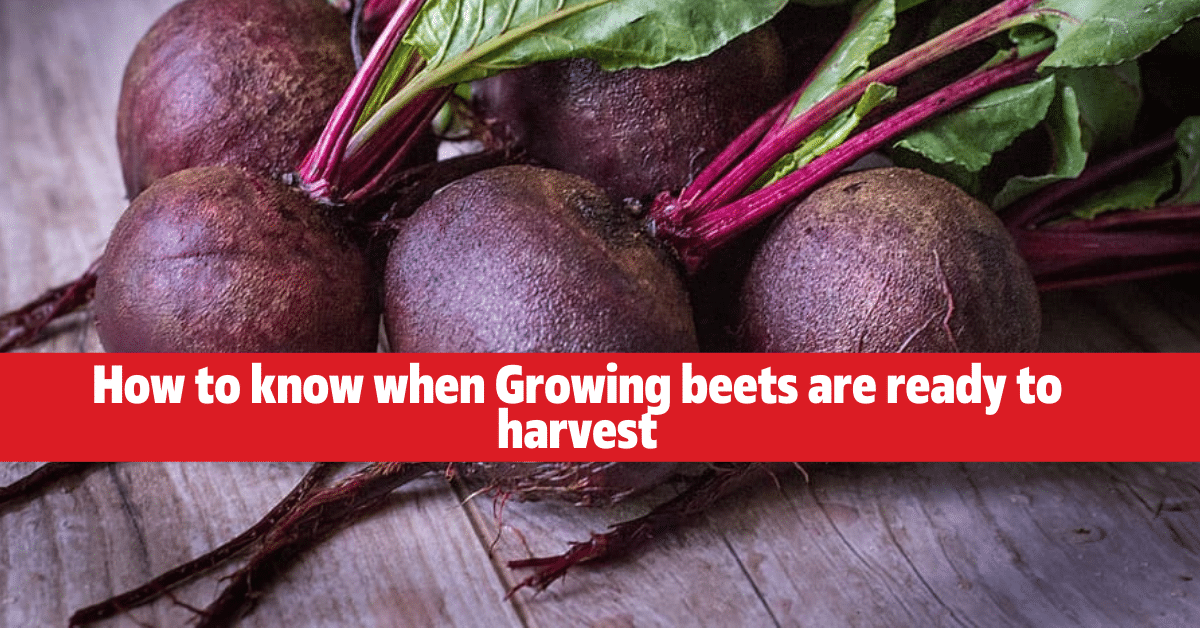How to know when Growing Beets are ready to harvest? Beets are a cool-season trim and fill well in the cool temperatures of spring and fall. They do inadequately in a sweltering climate. Beetroot plants are appropriate to huge or little home nurseries since they require little room. They are developed for both the roots, which generally are salted and the youthful tops, which are utilized as greens. Around 10 feet of column for every individual will give enough beets to utilize new or for canning.
How to know when beets are ready to harvest beets are a cool-season trim and fill well in the cool temperatures of spring and fall. They do inadequately in a sweltering climate. Beetroot plants are appropriate to huge or little home nurseries since they require little room. One develops them for both the roots, which generally are salted and the youthful tops, which are utilized as greens. Around 10 feet of column for every individual will give enough beets to utilize new or for canning.
Beets are probably the most straightforward vegetable you can develop. They’re never pained by vermin or infection. They needn’t bother with marking, pruning, or objecting. Plant the seeds and let the plants develop for around 6 to two months. Beetroot cultivation depends on the season of midsummer and pre-winter.
An Overview Of Growing Beets
Biological Name
Beta vulgaris
Plant Type
Edible Roots and Leaves
Maturity Period
50 to 70 days
Maturity Size
12 to 18 inches tall, 18 to 24 inches wide
Soil Type
Loamy
Soil pH
6.0–7.0 (slightly acidic to neutral)
Exposure
Full sun and part shade
Hardiness (USDA Zone)
2–11
Spacing
The space between the rows must be 30 to 40 cm
Bloom Time
Not grown for flowers
Toxity
Non-toxic
Flower Color
N/A
Growth Rate
120 days
Native Zone
Europe
Maintenance
General care and maintenance Beets require plenty of moisture to develop optimally. Even watering will promote the development of good quality roots and prevent the formation of rings in the root.
History of Growing Beets
Beets—or “beetroots“— are a bright, cool-season crop that is not difficult to develop from seed in decidedly ready soil and fills rapidly in full sun.
They are an extraordinary decision for northern nursery workers since they can endure ice and close frosty temperatures. This likewise makes them incredible as a fall crop.
On the off chance that you are a fledgling, search for bolt-safe assortments, which have to a lesser extent an opportunity of shooting (developing excessively fast) in a warm climate. There is a wide range of assortments of beets, exhibiting dark red, yellow, white, or striped foundations of various shapes.
You can gather Beetroots from the time they’re about the size of a golf ball to the size of a tennis ball; more extensive roots might be extreme and woody. Also, beet greens have a delightful and particular flavor and hold much more sustenance than the roots!
Variety Of Beets
Beets come in a significant number of shapes and a rainbow of shadings. Dark red is ordinary, yet yellow and white assortments are likewise accessible, as are red-white ringed ones (presented underneath)!
- ‘Chioggia’: red skin; when cut open, uncovers red and white concentric rings.
- ‘Detroit Dark Red’: Sturdy, usual assortment. Round, red root.
- ‘Formanova’: Long, round and hollow beets that fill in a similar design as carrots. Amazing for canning.
- Yellow assortments incorporate ‘Bolder’ or ‘Standard Gold.’
- White assortments incorporate ‘Torrential slide’ or Dutch legacy ‘Pale skinned person.’
Planting Growing Beets
When To Plant Growing Beets
- Start your first round of growing beets in late winter, when the dirt is serviceable. Make progressive plantings each 2 to 3 weeks until mid-summer.
- Planting beets are conceivable through summer as long as daytime temperatures surpass 75°F (24°C).
- In soil at any rate 50°F (10°C), germination happens in 5 to 8 days. In soil colder than that, germination may take 2 to 3 weeks.
- For a fall reap, plant beet seeds from mid-summer through late-summer, beginning around 4 to about a month and a half before your first fall ice.
- Winter crops are an unmistakable chance in Zone 9 and hotter. Plant beets in ahead of schedule to pre-winter for a colder time of year reap.
In northern soils, beets shouldn’t be planted until the dirt temperature is at any rate 40 degrees F. (4 C.). Beets like a cool climate, so it’s ideal for planting them during this time. They fill well in the cooler temperatures of spring and fall and do inadequately in a sweltering climate.
Where To Growing Beets
Like most vegetables, beets incline toward filling in full sun, and they like to get around 1″ of water every week. Beets are cold, lenient to be planted in late winter, a little while before the last ice date. To keep the dirt reliably clammy during germination, cover the territory with column cover until the seedlings break the dirt surface.
Grow Beetroot plants in the garden
When considering how to develop beets in the nursery, don’t disregard the dirt.
Beets do best in profound, very much depleted soil, but never mud, which is excessively weighty for massive roots to develop.
Dirt soil ought to be blended in with natural make a difference to help mellow it. Hard soil can make the underlying foundations of the beet extreme. Sandy soil is ideal.
On the off chance that you plant beets in the fall, utilize a somewhat heavier soil to help secure against any early ice.
Grow beetroot in a modular tray
Beetroots can be planted in modular plates to give them a head start and security from climate and nursery bugs.
Utilize seed manure which has a better surface and lower supplements than your standard multipurpose fertilizer.
We utilize a seed module plate, with each segment being approx 2 inches down. Fill the seed plate with manure and forget about any abundance.
When filling the plate, rub the fertilizer through your hands to separate any knots. Later on, the seeds will begin to sprout, and the beet seeds will develop.
Planting Beetroot
Mulch and afterward water routinely with around 1 inch of water for every square foot each week. Beets need to keep up a lot of dampness to develop well.
Weed depending on the situation; however, be delicate around young plants; beets have shallow roots that are effortlessly upset.
Consider covering beets with a column cover to forestall bothers like leaf excavators from assaulting the plants’ leaves.
Enhancing with additional compost is generally excessive. If you prepare, back off of nitrogen; overabundance will cause an abundance of greens, however tiny bulbs underneath the dirt.
Harvesting Growing Beets For Canning
Canning beets is a simple method to save them for all-year use. Pull out the pressing factor canner and can plain beets for servings of mixed greens, soups, or simply delicious bites. Growing Beets are ideal for canning, and they hold up to the high temps of a pressing factor canner delightfully. In truth, it’s exciting to differentiate between a newly cooked beet and a canned one.
Caring Of Beets
Pests And Disease
Numerous insect poisons are accessible in garden communities for mortgage holder use. Sevin® is a manufactured insect spray, while Bt-based insect sprays and sulfur are natural alternatives. Sulfur additionally has fungicidal properties and helps control numerous illnesses.
- Insect Beetles
- Leaf Miners
- Leaf spot
- Cercospora
- Leafhoppers
Caring Tips During Plantation
Days to development will, in general, be somewhere in the range of 55 and 70 for most assortments.
Reap roots when golf-ball-size or bigger; exceptionally enormous roots might be intense and woody.
Release the dirt around the beet and tenderly draw it from the earth.
Reap the beet greens at practically any time, starting when diminishing seedlings.
Harvesting And Storage
The best beets are no more significant than a tennis ball and can be pulled effectively when they have arrived at the necessary size. More giant beets can be developed whenever required; however, guarantee they are constantly kept very much water or get extreme and woody.
If you have developed a few roots for capacity, these ought to be lifted on a dry day toward the finish of September into October. Pull them by hand if conceivable. A fork can be utilized to release roots around the plant, being mindful not to harm the root.
Eliminate the foliage to around 50 mm(2″) over the crown and turn the foliage off instead of cut with a blade, as this will make the stalks drain. Reject any harmed roots or any that bugs have assaulted. Harmed beetroot may spoil away.
Recipes
- Beet Soup
- Pickled Beets
- Salad with fruits and veggies
Uses of Growing Beets
Beets are stacked with nutrients and minerals and low in calories and fat. They additionally contain inorganic nitrates and colors, the two of which have various medical advantages.
Beets contain a high centralization of nitrates, which have a pulse bringing down impact. This may prompt a decreased danger of coronary episodes, cardiovascular breakdown, and stroke.
Eating beets may upgrade athletic execution by improving oxygen use and time to depletion. To augment their belongings, beets should be burned for 2–3 hours before preparing or contending.

